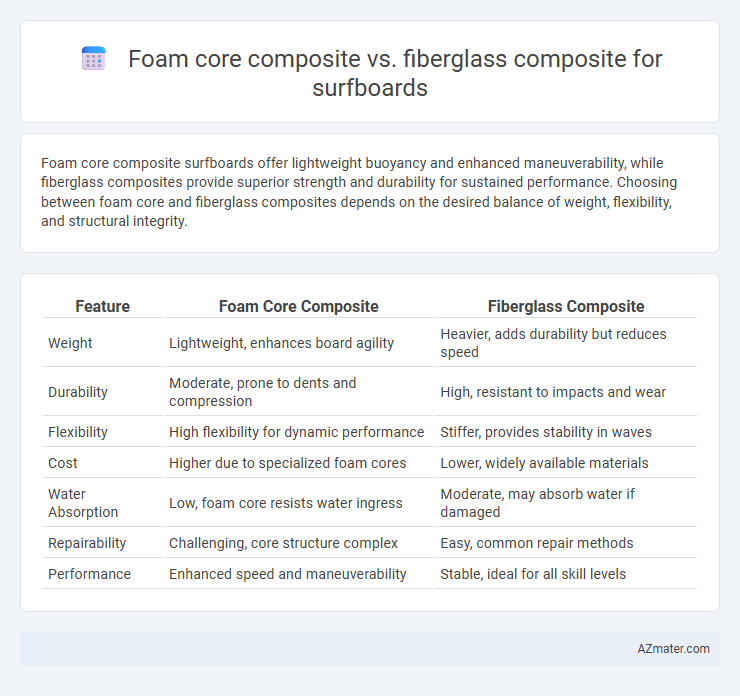Foam core composite surfboards offer lightweight buoyancy and enhanced maneuverability, while fiberglass composites provide superior strength and durability for sustained performance. Choosing between foam core and fiberglass composites depends on the desired balance of weight, flexibility, and structural integrity.
Table of Comparison
| Feature | Foam Core Composite | Fiberglass Composite |
|---|---|---|
| Weight | Lightweight, enhances board agility | Heavier, adds durability but reduces speed |
| Durability | Moderate, prone to dents and compression | High, resistant to impacts and wear |
| Flexibility | High flexibility for dynamic performance | Stiffer, provides stability in waves |
| Cost | Higher due to specialized foam cores | Lower, widely available materials |
| Water Absorption | Low, foam core resists water ingress | Moderate, may absorb water if damaged |
| Repairability | Challenging, core structure complex | Easy, common repair methods |
| Performance | Enhanced speed and maneuverability | Stable, ideal for all skill levels |
Introduction to Surfboard Construction Materials
Foam core composites provide lightweight buoyancy and excellent flexibility, making them ideal for responsive surfboards suitable for various wave conditions. Fiberglass composites offer durability and strength through layers of woven fiberglass cloth saturated with resin, enhancing the board's rigidity and impact resistance. Both materials are widely used in surfboard construction, with foam cores forming the shape and fiberglass composites adding protective structural reinforcement.
What is Foam Core Composite?
Foam core composite surfboards feature a lightweight polystyrene or polyurethane foam center wrapped in fiberglass cloth and resin, offering enhanced buoyancy and maneuverability compared to traditional solid boards. This construction allows for precise shaping and a balance of strength and flexibility, making them popular among surfers seeking performance and durability. Foam core composites are favored for their reduced weight and improved impact resistance, essential for a responsive and long-lasting surfboard.
What is Fiberglass Composite?
Fiberglass composite is a widely used material in surfboard manufacturing, consisting of woven glass fibers embedded in a resin matrix, typically polyester or epoxy, providing high strength-to-weight ratio and excellent durability. This composite offers enhanced flex and impact resistance compared to foam core alone, making it ideal for performance surfboards requiring a balance of flexibility and toughness. Fiberglass composites also allow for a smooth, glossy finish, improving board aesthetics and hydrodynamics.
Weight and Performance Differences
Foam core composites significantly reduce surfboard weight compared to fiberglass composites, enabling enhanced maneuverability and quicker response on waves. Foam cores provide superior buoyancy and flexibility, resulting in improved performance for dynamic surfing styles. Fiberglass composites offer greater durability but add bulk, often slowing the board and reducing agility in complex wave conditions.
Durability and Lifespan Comparison
Foam core composites in surfboards offer lightweight performance but generally exhibit lower impact resistance and shorter lifespan compared to fiberglass composites. Fiberglass composites provide superior durability due to their robust resin-saturated fiberglass layers, which resist dings, cracks, and wear over extended use. The enhanced structural integrity of fiberglass composites results in longer-lasting surfboards that maintain shape and performance under rigorous conditions.
Flexibility and Ride Quality
Foam core composites offer superior flexibility, allowing surfboards to absorb wave energy and provide a lively, responsive ride ideal for dynamic maneuvers. Fiberglass composites are stiffer and more durable, delivering a smoother, more stable ride that excels in larger, powerful waves. The choice between foam core and fiberglass impacts ride quality, with foam cores favoring agility and fiberglass prioritizing strength and control.
Environmental Impact and Sustainability
Foam core composites in surfboards typically rely on polyurethane or polystyrene foams, which are non-biodegradable and derived from petroleum-based resources, leading to greater environmental impacts in production and disposal. Fiberglass composites involve layers of glass fiber and resin, often polyester or epoxy, which pose challenges in recycling and contribute to landfill waste but sometimes incorporate bio-based resins improving ecological footprints. Sustainable alternatives prioritize plant-based foam cores and recyclable or bio-resin fiberglass laminates, lowering carbon footprints and pollution compared to traditional synthetic materials used in surfboard construction.
Cost Considerations for Surfers
Foam core composites for surfboards generally offer a more affordable option due to lower material and manufacturing costs compared to fiberglass composites, making them attractive for budget-conscious surfers. Fiberglass composites provide enhanced durability and performance but come with higher expenses related to materials and labor-intensive lamination processes. Surfers weighing cost heavily may prefer foam core boards while those prioritizing longevity and strength might justify the premium price of fiberglass composite surfboards.
Popular Brands and Models Using Each Material
Popular surfboard brands like Firewire and Haydenshapes frequently use foam core composites, leveraging EPS (expanded polystyrene) or PU (polyurethane) foam cores wrapped in fiberglass to enhance strength and reduce weight. Fiberglass composite boards, favored by brands such as Channel Islands and Lost Surfboards, utilize traditional EPS cores with heavier, woven fiberglass cloth encapsulation for durability and performance in various wave conditions. Models like Firewire's Seaside and Channel Islands' CI Flyer exemplify the use of foam core and fiberglass composites, respectively, highlighting distinct material benefits preferred by surfers.
Choosing the Right Composite for Your Surfing Style
Foam core composites offer lighter weight and enhanced maneuverability, ideal for surfers seeking agility and quick turns in small to medium waves. Fiberglass composites provide superior durability and stiffness, making them better suited for powerful surfing and larger, more challenging waves. Selecting the right composite depends on your preferred wave conditions and desired board performance, with foam cores favoring responsiveness and fiberglass emphasizing strength.

Infographic: Foam core composite vs Fiberglass composite for Surfboard
 azmater.com
azmater.com